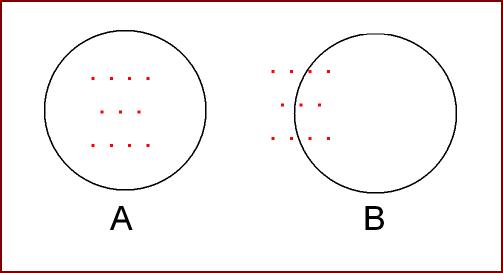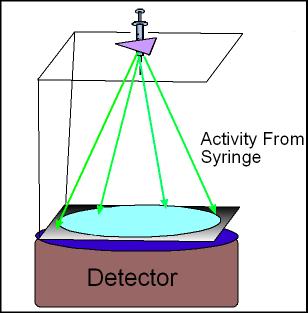General Comments About Renal Quantification
Before we discuss specific processes of renal quantification (ROIs) we need to consider how accurate the data is when quantifying a renal exam.
- General comments
- First let us consider the difference between being accurate and precise by noting the diagram below

- Consider the following above diagram and relate this to then accuracy of an exam where:
- A - represents an exams ability to accurately diagnose disease
- B - represents an exams ability to be precise, but is not accurate
- Renograms do not necessarily give an exact or accurate information, however, if the procedure is followed correctly, it should always be precise
- Hence, knowing the limitations of a renogram and its diagnostic values an appropriate diagnosis can be given
- Also, the more quantification that can be applied, the more information can be extrapolated
- Note - the basic information usually attained from a renogram is the use of drawing ROIs around both kidneys and generating a time/activity curve
- Therefore, if we acquire additional information, such as external syringe counting and/or plasma counting the procedure becomes more accurate
- Plasma counting
- Prior to injecting a radiopharmaceutical (ex. 99mTc-MAG3) a standard is obtained from the radiopharmaceutical being injected
- Dose is injected and data is acquired
- At or around 44 minutes a sample of the patient's blood is extracted
- Plasma activity is then compared to the standard to determine the amount of the radiotracer excreted or noting the amount activity remaining in the plasma
- External syringe counting
- Maybe combined with plasma counting
- A pre-syringe count is acquired with the camera, just prior to the procedure in order to determines the amount of activity being injected into the patient

- Once the renogram procedure is completed a post syringe count is also acquire, in order to determine exactly how much activity was injected into the patient
- Comments on syringe counting
- Note the distance between the syringe and the detector - this is done in order to mimic distance of the kidneys to the detector, when data from the renogram is acquired
- By acquiring a pre and post syringe count the computer determines the amount of activity that has been injected into the patient
- This data is then quantified into the ROI program for further analysis of ERPF and/or GFR calculations
- The computer then calculates the amount of activity injected into the patient and also the amount of the radiotracer excreted through the kidney
- Work sheet for determining GFR
- Worksheet for determining %EFPF
- Excretion Index (EI)
- This data can be added to either of the above calculations
- Following the injection of the radiopharmaceutical and acquisition of the renogram the urine excreted by the patient is collected and the amount of activity in the urine determines the amount of excreted radiopharmaceutical. This is known as EI
Return to the beginning of the document
Return to the Table of Contents
6/23

